OLMSTED AND SCENIC PRESERVATION
Frederick Law Olmsted is rightly remembered as the most accomplished landscape architect in U.S. history, the designer of great municipal parks and other landscapes. He also was a key figure in the nation’s most significant early examples of scenic preservation. These endeavors were not mutually exclusive, and in fact park design and scenic preservation were both aspects of the practice of landscape architecture Olmsted developed in the second half of the nineteenth century. Public parks of all types—from municipal pleasure grounds to state and national reservations—made it possible for the general public, not just a wealthy few, to experience a wide range of landscape scenery. Olmsted believed such experiences were vital to the health and well being of individuals, and therefore of society as a whole. If Central Park provided beautiful and picturesque scenes for New Yorkers, Niagara Falls and Yosemite Valley gave visiting tourists a different scale of sublime landscape experience. In the first case, extensive grading, planting, and other improvements were required to transform the Central Park site into a dramatic sequence of landscapes. At Yosemite and Niagara, the challenge for the landscape architect was to protect existing features from the damage that visitors could do, and to choreograph the sequence and pace of their experience in the design of roads, paths, and other facilities.
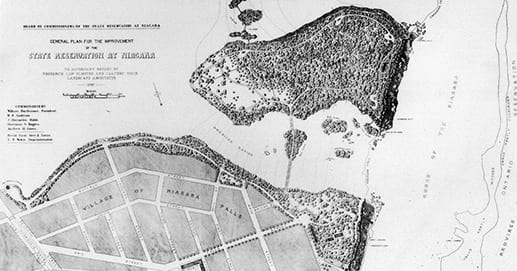
Olmsted described these intentions for preserving an existing scenic landscape as a public park in the Yosemite Valley report he prepared while Central Park was still under construction.1 In 1864, Olmsted was living in Bear Valley, California, when Congress passed the Yosemite Grant that ceded the nearby Yosemite Valley and Mariposa Grove of giant sequoias to the State of California for public park purposes. Olmsted had no hand in the legislation but the governor appointed him to head the commission charged with managing the new park. The report Olmsted wrote in 1865 outlined a program of minimal, unobtrusive development (including paths, overlooks, carriage roads, and camping facilities) that would allow what he foresaw would eventually be millions of visitors to the valley to have a full experience of it, while keeping the landscape as undeveloped and undisturbed as possible.
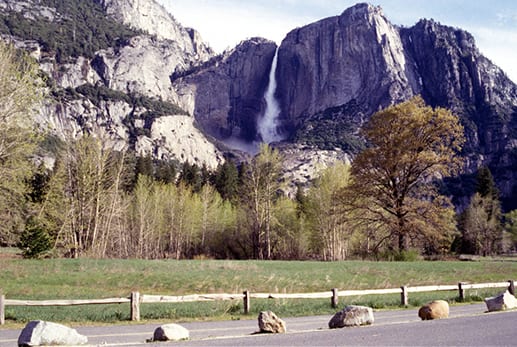
Olmsted went much further in his report (as he often did in his park reports), providing the fundamental intellectual framework for federal park making. He noted that it was “the main duty of government” to protect and provide the means for the “pursuit of happiness.” That pursuit, for Olmsted, depended on preserving places such as Yosemite Valley and creating public access to them. “It is a scientific fact,” he asserted, “that the occasional contemplation of natural scenes of an impressive character, particularly if this contemplation occurs in connection with relief from ordinary cares, change of air and change of habits, is favorable to the health and vigor of men…beyond any other conditions that can be offered them.” Government had nothing less than a duty to assure “enjoyment of the choicest natural scenes in the country and the means of recreation associated with them” be “laid open to the use of the body of the people,” because if government did not act, those places would be monopolized by the few and experienced only by the elite. “The establishment by government of great public grounds for the free enjoyment of the people” therefore was justified—in fact was required—of a republican form of government that derived its authority from its people, not an aristocracy.
Olmsted returned east in 1865, and while his Yosemite report was not made the basis for state management of Yosemite Valley, he was soon involved in another landmark scenic preservation project. Olmsted advocated for the preservation of Niagara Falls beginning at least the late 1860s, when he was at work designing the municipal park system of nearby Buffalo. Hotels and tourist attractions had grown up around Niagara for decades, forcing tourists to pay to gain access to overlooks and creating what many considered an inappropriate setting for the awesome spectacle. In 1879 the New York legislature appointed Olmsted, with the Director of the New York State Survey, James T. Gardner, to prepare a special report on conditions at the Falls.2 Their report emphasized the need to preserve the surrounding landscape, especially Goat Island, which separated the American and Canadian falls, and the shoreline along the rapids above the falls, which was lined with buildings. The report also contained a petition, which Olmsted and his friend the Harvard art historian Charles Eliot Norton had drawn up and circulated. Signed by leading cultural and political figures in the United States, Canada, and Great Britain, the document urged the state to acquire the private property around the falls and provide for a better form of public access. Olmsted worked with a number of colleagues, especially Norton, to orchestrate a campaign to influence public opinion, a first of its type in the cause of scenic preservation in the U.S. The two men hired journalists Henry Norman and Jonathan B. Harrison to write articles on conditions at Niagara and on the legislation proposed to remedy them. Their efforts received a boost following the 1882 election of a supporter, Grover Cleveland (then the mayor of Buffalo), as governor of New York State. Olmsted and Norton helped found the Niagara Falls Association early in 1883, a group that intensified the effort to persuade the state legislature to act. Later that year the legislature approved a bill to establish the Niagara Reservation, and Cleveland signed it. In 1885, the same body finally appropriated funds to establish the reservation, and it became the first park of its type to be created by a state government.3
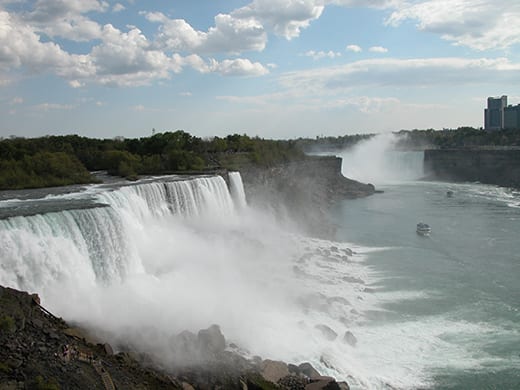
In 1886, Olmsted finally had the opportunity to design the state reservation around Niagara Falls, working in collaboration with his old partner, the architect Calvert Vaux. Olmsted had been far more involved than Vaux in planning and advocacy for Niagara, but he acknowledged that Vaux had an important role in their work together, which they completed in early 1887. The Niagara report demonstrated how landscape architecture could be used to preserve and to restore a scenic landscape through the acquisition of private property, the removal of previous development, and the facilitation of public access through the construction of park drives, paths, overlooks, and limited visitor amenities.4 Through the development of the area as a park, more destructive forms of resort development were avoided and the public had opportunities for more meaningful experiences of a place that otherwise might be dominated by commercial enterprises.
Olmsted was able to see his plans for Niagara come to fruition, but the management of Yosemite Valley had taken a different direction. Olmsted would return to California several times in the 1880s, after he received the important commission to design the Stanford campus. On none of these trips did he return to Yosemite Valley. On the first trip in 1886, he did travel to the nearby Mariposa Grove and visited with Galen Clark, who had been a fellow member of the first Yosemite Commission. Clark and Olmsted probably discussed conditions in the nearby valley where, since Olmsted’s last visit in 1865, much of the development and damage that he had warned against had occurred. Without the road to Stockton, supplies of all types were expensive to bring into the valley. As a result, many of the valley’s delicate meadows were now cultivated or used for pastures, and trees were harvested and milled into lumber. Large hotels were built, rather than the simple camping stations Olmsted had advised, and numerous other businesses were established through permits issued by the state commissioners. The valley was changing in other ways, as well. By the 1880s, some visitors complained that new tree growth was cutting off views and changing the character of the landscape. Although it was not well understood at the time, for centuries Native Americans had used fire to control the growth of vegetation in the valley, a practice that ended after 1864. By the 1880s, vegetation was rapidly encroaching into the valley’s meadows, and park concessioners and managers reacted by removing and pruning trees, a practice that soon incited a negative reaction among preservationists who felt such tree cutting was inimical to the park’s purpose.5 During his 1886 trip, Olmsted was under pressure to work on the Stanford commission and to complete other business in California. But he may have had other reasons for choosing not to enter the valley that he had described movingly in 1865 as “the greatest glory of nature.”
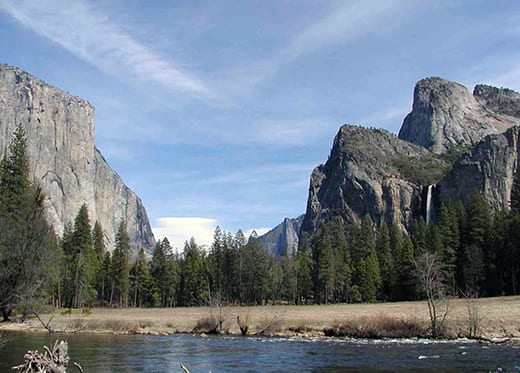
Olmsted was drawn into commenting on conditions at Yosemite, nonetheless. In 1889, Robert Underwood Johnson, then associate editor of Century magazine, spent two weeks camping in and around Yosemite Valley with John Muir, the writer and wilderness preservation advocate. Muir enlisted Underwood in the cause of creating a larger Yosemite National Park around Yosemite Valley itself (which remained a state park at this time). Muir and Underwood also sought to reform the state’s management of Yosemite Valley and criticized many aspects of the Yosemite commission’s policies. Johnson wrote Olmsted and described what he considered the destructive removal of trees and other vegetation and the generally poor condition of the valley landscape.6 He wanted Olmsted to consider taking a consulting position with the state park commission, and he offered to intercede with Governor Leland Stanford to make the appointment possible. At the very least, the editor wanted Olmsted to write on the subject for Century.7 Olmsted, who had just completed his definitive statement on the “use of the axe” in landscape management—a long and thoroughly documented defense of tree thinning—replied to Johnson only after considerable reflection.8 He eventually declined to write the article or to become more actively involved in the criticism of the Yosemite commissioners. While he sympathized with his friend’s position and knew the management of the valley needed improvement, he was unwilling to condemn the commissioners without better knowledge of what exactly had been done and why. “All I could say,” he wrote that fall, “is that, having at an early day spent several months in the valley under peculiarly favorable circumstances for contemplating it, I know that the question is one of far greater importance and of far greater difficulty than can be generally realized; that it is most foolish to take it up in an occasional and desultory way as a question of details, or as a question the answer to which will be chiefly important to the people of the present century. It is preeminently a question of our duty to the future.”9
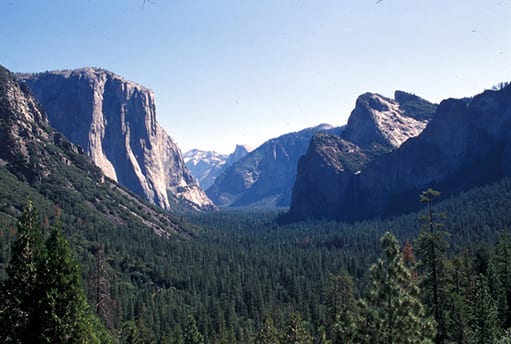
Olmsted might have continued to remain silent on the subject of Yosemite Valley, but in the spring of 1890 the governor of California, Robert W. Waterman, made a ludicrous claim that Johnson was disparaging the Yosemite commission solely for the purpose of obtaining a professional appointment for his “uncle,” Frederick Law Olmsted. Olmsted now felt compelled to address the situation, and did so with a pamphlet published at his own expense, Governmental Preservation of Natural Scenery.10 He gave an account of his involvement with Yosemite Valley and the Mariposa Grove since 1864, and he declined once again to criticize the state commissioners since he had not made a thorough study of their policies and actions. He refused to condemn tree removal, per se, in the valley, but clarified that done incorrectly (as Johnson and others had claimed it was) the effects would be disastrous. The Yosemite commissioners, who had other areas of expertise, should not be expected to know the difference; landscape architects, who were specifically trained to make such judgments, should. While Olmsted declined to give any further advice on the management of valley landscape specifically, he gave a long quotation from the 1887 Niagara report that he felt should serve the general purpose of guiding Yosemite policy, and in so doing made it clear how closely these two great experiments in landscape preservation were linked. “Nothing of an artificial character should be allowed a place on the property,” he and Vaux wrote regarding the Niagara Reservation, “no matter how valuable it might be under other circumstances, and no matter at how little cost it may be had, the presence of which can be avoided consistently with the provision of necessary conditions for making the enjoyment of the natural scenery available.”
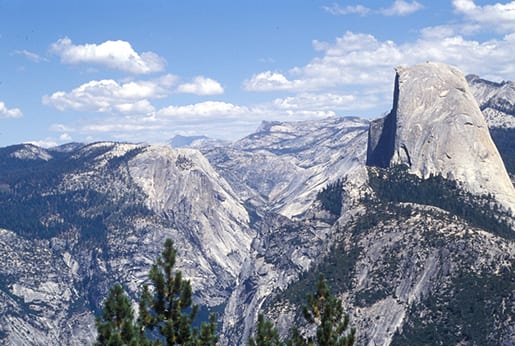
Scenic preservation was not ancillary to Olmsted’s practice of landscape architecture, but integral to the theory as well as techniques of landscape design he developed. Today, we tend to think of landscape design on the one hand, as changing and adapting landscapes to new or altered purposes, and preservation on the other, as almost the opposite, preventing change and maintaining existing uses and character. But in fact Olmsted’s approach to landscape design involved a lot of preservation, while the preservation of Niagara, for example, required extensive new design. Public parks of all types also shared a basic purpose for Olmsted: assuring that varied and profound experiences of landscape beauty, from the pastoral expanses of his city parks to the most dramatic landscape features of the continent, would be accessible to everyone. The common thread was the benefit to individuals and to society that could only be achieved through the creation of a full range of accessible parks and reservations, assuring a more healthful and functional civilization.
Ethan Carr, FASLA
Professor, University of Massachusetts
Department of Landscape Architecture and Regional Planning
Images from top to bottom: Olmsted and Vaux, 1887, State Reservation at Niagara. Photo courtesy of FLO National Historic Site; Yosemite Falls; Niagara Falls and Goat Island; Yosemite Valley in April; Yosemite Valley from Wawona Road Entrance; Yosemite Valley from Glacier Point.
All photos courtesy of the author unless otherwise noted.
1. FLO, “Preliminary Report on the Yosemite and Big Tree Grove,” 1865 (Papers of FLO, 5: 488-516).
2. FLO, “Notes by Mr. Olmsted,” in Special Report of New York State Survey on the Preservation of the Scenery of Niagara Falls for the Year 1879 [c. March 22, 1880] (Papers of FLO 7: 474-481).
3. See Papers of FLO SS1: 46-53.
4. FLO and Calvert Vaux, “General Plan for the Improvement of the Niagara Reservation,” 1887 (Papers of FLO, SS1: 535-75).
5. Alfred Runte, Yosemite: The Embattled Wilderness (Lincoln, Nebraska, 1990), pp. 38-39;49-54.
6. See FLO to Richard W. Gilder, July 10, 1889 (Papers of FLO, Library of Congress).
7. Robert U. Johnson to FLO, June 23, 1889 (Papers of FLO, Library of Congress).
8. FLO and Jonathan B. Harrison, Observations on the Treatment of Public Plantations, More Especially Relating to the Use of the Axe, [1889] reprinted in Landscape Architecture 3, no. 4 (July 1913): 145-152.
9. FLO to Robert U. Johnson, Oct. 9, 1889 (Papers of FLO, Library of Congress).
10. FLO, Governmental Preservation of Natural Scenery, March 8, 1890 (Papers of FLO, Library of Congress).